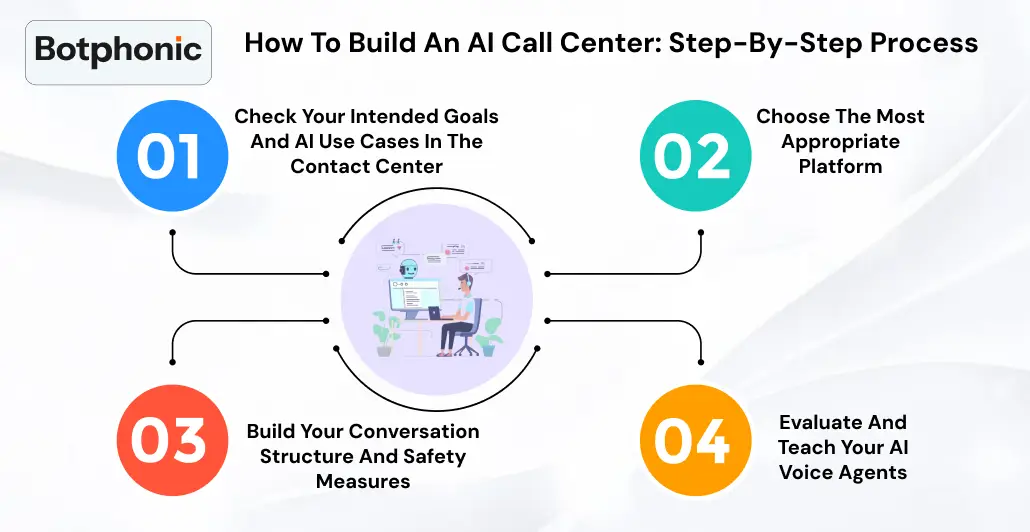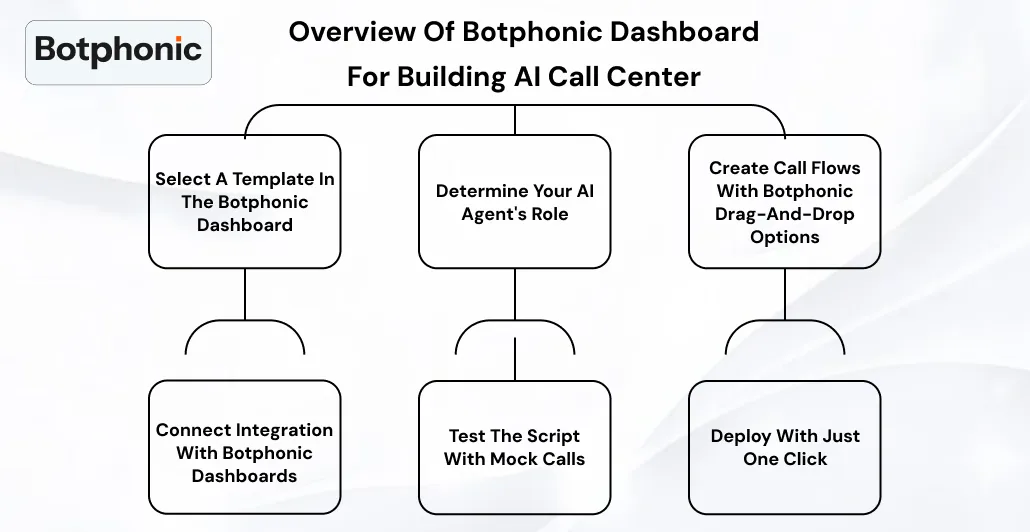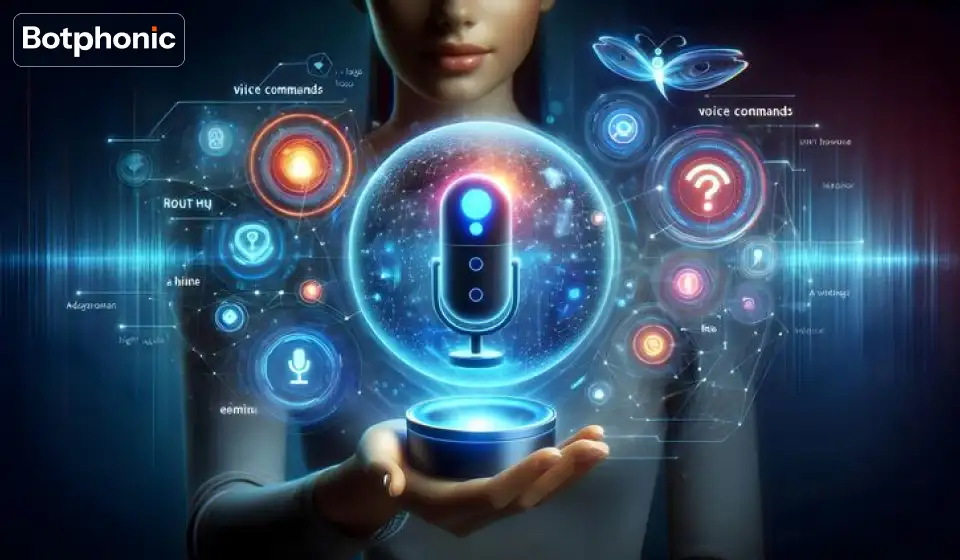
Summarize Content With:
Summary
Imagine it’s 3 am, and a customer is asking details about your product?? This used to happen before. Right?? Your customer had to wait until morning, or you’ll need to hire more people to work at night. But nowadays, the scenario has been changed. AI in contact centers provides instant responses to customers—polite, concise, and 100% true.
If your AI agents handle your call operations without breaks and without errors, don’t you think your customer experience will boost to 10x??? Whether you are a startup, a mid-size company, or a global brand, building your own AI model is simple and budget-friendly. In this blog, I will provide you informative insights on ‘How to build an AI call center.”
Without killing the vibe, let’s begin!!!
Introduction
AI call centers are becoming a game-changing platform for business. In the traditional system, customers need help from human agents to resolve their queries, and also agents need to follow a script while interacting with customers. But now, the scenario has been changed; AI agents are handling all the mundane, repetitive tasks of agents that are time-consuming and nerve-racking.
Are you still struggling with resolving the repetitive questions of customers throughout the day?? Have you noticed your agents getting stressed out with this monotonous routine?? Then, AI in customer support is the optimum approach to this problem.
In customer support, AI agents recognize problems similar to humans and respond to incoming and outgoing calls competently. According to recent reports, the global conversational AI agent market will reach $47.6 billion in 2030 with 22.6% annual growth. This means businesses are implementing AI rapidly, as it saves production costs and elevates customer contentment.
The technology that works behind the entire workflow is LLM (large language model). It helps phone call AI to understand customer mood, intent, and buying preferences. But if the call center voice AI models are not being instructed accurately, they usually hallucinate—that means they provide wrong information to customers. By leveraging AI voice assistance like Botphonic, you can create your AI call center without the need for coding. Are you ready to build your AI call center?? Let’s begin.
How to Build an AI Call Center: Step-by-Step Process

I hope you got the brief understanding of AI call assistance. Next, I will discuss a few steps to help you create AI in the contact center.
Step 1: Check your intended goals and AI use cases in the contact center.
The first step is to determine clear intended objectives for your AI building in the call center.
In simple words, I can say, “How do you want your AI agents to perform in your business operations?” Check whether you want to improve your customer support or qualify leads or you want to optimize your appointment scheduling tasks.
Then, check what the most common call situations are in your business. Like:
- Do they need to track product status?
- Do customers mostly inquire about products?
- Are your user inquiries concerning deals and discounts?
- Or, do they just place a query for resolving complaints?
Next, you need to think, what is the meaning of successful calls?
- To make your customer happy?
- To resolve their problems?
- Or to successfully complete the sales process.
For example, you are running a healthcare sector. What are tasks you want your AI agents to automate? Appointment booking, sending confirmation mails, resolving billing-related inquiries, information related to insurance, or more. Make notes of all the points and start training your AI models as per that.
Step 2: Choose the most appropriate platform.
After defining your intention, your next step is to choose the appropriate platform and type of tool you prefer to build a contact center automation.
- No-code platform
If you have no coding experience and want to construct a fast preliminary setup for your business, then a no-coding platform (Botphonic) is best for you.
Botphonic provides drag-and-drop-style tools; you just need to arrange blocks, and your AI call center gets ready in a few minutes. Botphonic is the recommended platform for nontechnical users if you want the configuration fast and require deep customization of your product features.
- Customise solution
If your business needs more flexibility, or you need to create a complex workflow, or you need to embed AI entirely in the system, then select the custom coding path. Further, you can create Dialogueflow API integration by taking help from voice assistance AI company Botphonic.
Step 3. Build your conversation structure and safety measures.
After selecting the platform, now it’s time to train AI models. Firstly, you need to create a blueprint like AI conversation style, voice tone, writing style, greeting style, and script to follow while communicating with the customers. For best practice, speak about each and every step with your team and create all the scripts by considering your AI use cases in the contact center. Initially, you make mistakes, but don’t worry; over time, you will discover how your AI models can perform more efficiently.
- Design Basic prompts
Firstly, you need to figure out what types of prompts can cover all your business needs, AI traits, and voice style.
Example: AI should greet the customer properly and use customer names for a personalized touch and should provide answers to all the FAQs, escalate the issue to human agents wherever necessary, prepare notes of all the conversation, and provide valuable insights on agent performance. Before that, think: “Do you want to make your AI call assistant agents formal or friendly?”
- Conversational flow
First, collaborate with your team and construct a roadmap and include features such as AI agents that should ask:
basic questions such as customer name, order ID, and email, Greeting
Escalation triggers, details confirmation, and closing script. Tools like Botphonic help to manage inbound and outbound calls and escalate the customer issues to the right agent, without wasting time.
Build Your AI-Powered Call Center in Minutes Get Started
Connect with Bothphonic- Set Boundaries
Don’t make your AI super intelligent; instead, you should set some limitations to keep the system flow uninterrupted and to avoid any legal complications in the later part of your process. Try to limit the agent action and train AI agents on regulation and compliance, and set predefined responses. By implementing such a limitation, AI will avoid providing wrong information to users.
Step 4: Evaluate and teach your AI voice agents.
Let’s understand:
- Collection of data
First, you need to discover the most common question of your customers. Prepare a list of questions and train your AI models as per that. Evaluate:
Collate all the data of all the customer queries, prepare the list of FAQs that aligns with your product features, review the historical call records, and pick out the customer trouble spots.
- Customize AI answers to questions of customers.
So, finally, you have discovered the data. In the next step, you have to train your agents based on data of conversation AI use cases.
How will your AI in customer experience software handle the annoyed customer? Will you train your agents with a soft tone like “I understand your concerns, Joe,” or do you want to escalate the issues directly to human agents?
Then, start preparing scripts to train your AI agents. Implement the following steps: Start preparing ready-made templates on all the AI business use cases, such as greeting, billing status, product features, order status, and more.
Also, train your agents on edge cases; if a customer asks a sensitive question, they need to escalate the issue to human agents without any delay.
- Test the script
Before releasing the AI agents, it is crucial to check the working process. Further, test all the scripts and check whether the AI agents are giving responses as per the designed script.
Implement the following steps:
Check if the conversation is smooth or has interruptions in between. Check if the intent detection is accurate or not. Like if a customer asks, “I want to check my order status.” AI agents should be able to understand the customer context. Also, check if the conversation looks natural or not. Lastly, place dummy calls with your team to finalize the script.
Overview of Botphonic Dashboard for Building AI Call Center

Here I curated a list of steps to create an AI agent in Botphonic platforms. Let’s begin.
1. Select a template in the Botphonic dashboard.
First select the AI call assistant built-in blueprints from Botphonic dashboards. Further, it already has a script for call handling, so you don’t need to take on the hassle of building from scratch.
2. Determine your AI agent’s role.
Decide what types of roles you want your AI agents to perform.
- Greeting: How you want your AI agents to greet the customer.
- Primary responsibilities include resolving order issues, FAQs, appointment booking, and more.
- Escalation procedures: How to transfer the call to human agents, and what are the necessary factors? AI agents should evaluate before transferring.
3. Create call flows with Botphonic drag-and-drop options.
The Botphonic dashboard contains a visual editor and drag-and-drop options such as appointment scheduling, call booking, and FAQ answering.
4. Connect integration with Botphonic dashboards
- CRM (Zoho, Salesforce): to save data automatically in the system.
- Calendar (Google, Outlook): to automate the appointment scheduling as per the customer’s preferred date.
5. Test the script with mock calls
Create dummy calls to check how AI agents are responding to customer queries and how much improvement you still need.
6. Deploy with just one click
Click the publish option after finalizing the settings. You AI agents are now ready to go live!!!!
Conclusion
AI call centers are democratizing the customer services—providing a simple and powerful way to connect with the customers. Even small teams can provide 24/7 professional and customized services. No-code tools and visual editors are making the configuration easy. Businesses will see good results if they start the workflow with simple setups, make solid integrations, and keep human touch wherever necessary.
I hope the above article provides you some practical ways to build an AI call center. By complying with the above instructions, you can make your services fast and efficient and establish an outstanding position in the market.
Start your journey with Botphonic!! Connect with our team and book a free demo session!!!!

